Photo




Mixed Media Collage
Lino-print, newspaper, acrylic, oil and pen on paper
120cm x 55cm
This is the finished version of the mixed media collage I have been adding to this week. Overall, I’m really pleased with the final outcome of this,
I originally began working into the Lino-print with written text, writing ‘System Update’ at the top corner to make reference to digital terminology, suggesting that the system of power and the monarchy within the UK needs to be updated. However, I thought that there could be more effective methods of presenting. my ideas powerfully. The piece uses newspaper cuttings from a Socialist Worker’s Party newspaper. Though I don’t necessarily agree with or support the organisation’s Trotskyite beliefs, the paper was ideal for my work as it contained a lot of phrases and text relating to the monarchy and the Government which I could use in this piece to communicate an anti-establishment message. I think that the use of newspaper collage is effective in evoking the look of the DIY/Punk art movement, signifying working class anger, revolution and anarchist ideals. Taking into consideration my current visual research into conspiracy and systems of power, I also incorporated some of these symbols in this piece, using pen to depict the Illuminati triangle and pop culture references (The Beatle’s album ‘Help!’ scribbled below the image of the monarchy in the bottom left). I particularly like this section of the piece, with the ‘Love love love’ newspaper cuttings and the ‘Destruct’ text directly above the heads of the royal family, evoking a sort of tongue-in-cheek approach to the topic that I find easier to communicate my ideas without being completely serious. This also lends itself quite well to conspiracy theory, as it allows me to investigate the subject through a more flippant tone to give a degree of separation between my own beliefs and the ones communicated through the work.
I wasn’t completely happy with the look of this collage before painting on top of it, so i thought about how i could inject a colourful style into it that fits more with the aesthetics of my current practise. At the beginning of this semester I had briefly experimented with painted mandala motifs on top of mixed media collage, so once I had tested this out again I used it in this work. The slightly translucent properties of the oil paint makes the work more vibrant whilst the text is still visible underneath, allowing me to make reference to religious iconography and the outsider/punk aesthetic at the same time.
I definitely want to continue using collage in my work this way, I could return to this piece to add more intricate details to the mandalas painted on top.
2 notes
·
View notes
Photo

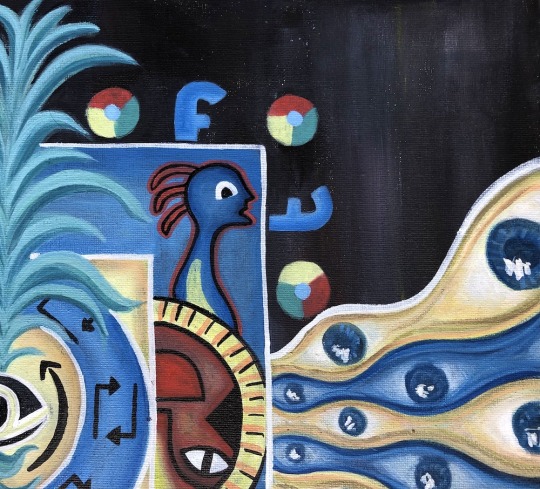

Artwork for PC2 Exhibition
oil on canvas
40cm x 60cm
Above is the finished painting that I produced for our gallery group exhibition. The work as featured as part of a printed Zine, as well as on our exhibition’s Instagram page.
I chose not to post this on my blog until we had the launch party and released images of all the artworks. I’m really happy with the look of this work, its possibly one of my favourite paintings I’ve produced this semester. I’m glad i spent a lot of time digitally drawing out the precise geometry of the shapes, and spent time getting the lines as accurate as possible. I also considered the use of colour a lot more here. Painting against a black background helped the colours to ‘pop’ a lot more - I’d like to create work against a darker background more often, as to me it really helped to evoke the tribal, artefact type of appearance in the work. I think it could potentially work nicely as a Lino-print as well. I could make a print out of it and work into it like i have been doing recently with my other prints. It may also look effective as a repeated pattern.
Working digitally first to map out my design idea worked well for me, helping me to make creative decisions without them being set in stone on the page. It is something I will definitely take with me into my next semester in third year.
0 notes
Photo
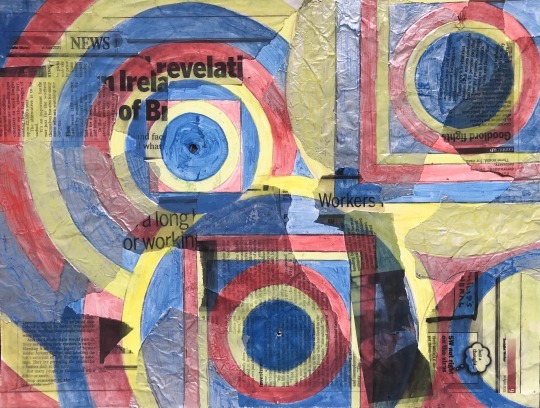

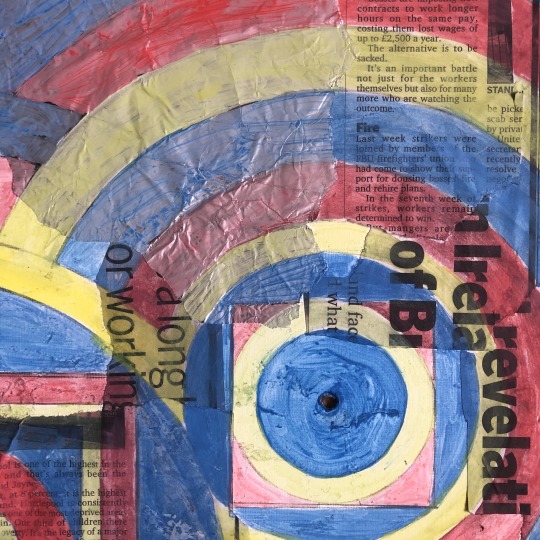
Testing out mixed media backgrounds and oil paint
40X30cm
Newspaper and Foil on paper, oil paint on top
Above is a piece of work I produced to test out using oil paint on top of newspaper, which would form the background of the larger mixed media piece I’m currently working on. I used both scrap newspaper cuttings and foil, glueing them on to form the background.
As this was just a test i didn’t intend to create any obvious meaning from the pieces I used, however the paper I used was taken from a scrap socialist newspaper, so naturally the contents are made up of words criticising the government and speaking about worker’s rights. I then sketched out mandala designs on top, painting in solid areas of colour in oil. I really like the way the oil dries translucent on top of the paper whilst also keeping quite a vibrant pigment. The overall look of it fits in nicely with the aesthetics of my work in general - bright primary colours. I can go on to use this on the larger collage piece knowing that it will be effective. I could continue using this technique with further mixed media pieces that I make, using oil to to add colourful designs reminiscent of religious imagery on top of the collages, creating a mix of local socio-political issues and broader transcendent concepts.
2 notes
·
View notes
Photo

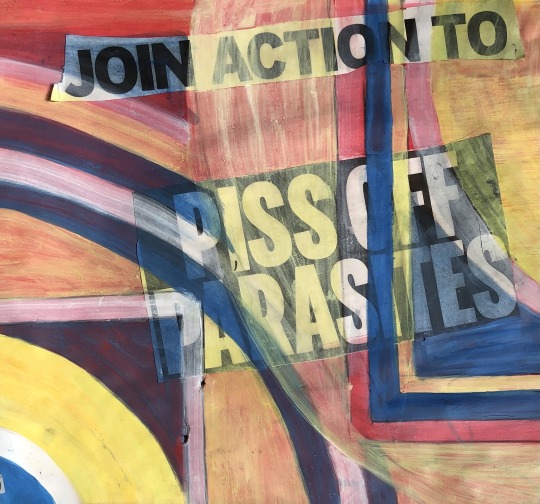

Experimenting with mixed-media collage
Acrylic, oil, pen, collage on paper
Close ups, entire piece is 120cm x 55cm
The images above are from a large roll of paper I have been working on, using my Lino-prints, newspaper cuttings, acrylic, and oil paint.
I began by working into one of the large prints I produced, using written text and newspaper letters to construct statements related to the abolishing the monarchy. I wanted to test out creating a layered piece of work with many different images and motifs, similar to the work of Steven Lebya that I have been looking at recently. I also used this piece to start bringing in some conspiracy related motifs, again using cutouts of eyes, illuminati symbols, pop culture references and royal figures, generating an amalgamation of many different strands that all relate to the British state.
I wasn’t that happy with the original appearance of this collage, I knew that working on a thin roll of paper, getting thick areas of solid colour would be difficult with acrylic paint. I wanted some of the text to be visible, but also wanted a highly colourful piece of work. I then began to consider my previous visual research relating to religious or spiritual iconography, and thought that it could look really interesting to have a thickly layered collage beneath an arrangement of mandala motifs in oil paint, so that the images show through. I began to paint this on top, working in primary colours all the way across the page.
I’m really pleased with the look of some of the areas pictured above. It has taken a while to put together, a good few days of arranging and layering, but I think that the use of collage to communicate my ideas work in relation to the theme of systems of power and conspiracy, having lots of different strands of information and references placed together to produce an ambiguous and interconnected web of ideas. Creating more of these that fill the page with many different leads could potentially allow the viewer to come to their own conclusions about the work, similar way that Herbert Bayer proposed the idea of using a mass of images in the exhibition ‘Family of man’ in 1955 (mentioned in my previous blog post) to allow the viewer to construct their own narrative from the images.
0 notes
Photo

Screenshot from Adam Curtis series ‘Cant Get You Out Of My Head’.
‘Diagram of Field of Vision by Herbert Bayer
Episode 6, 31:37
This part of the documentary discusses the ‘Family of Man’ exhibition – a 1955 exhibition that brought together photographs from all over the world as a celebration of the universal aspects of human experience, and as a declaration of global solidarity after WW2. The exhibition put forward a new way of seeing the world, as an alternative of Nazism and communism.
“Instead of being overwhelmed by dramatic stories created by those in power, the individuals would make their own story out of the photographs”
Herbert Bayer created the diagram shown above to illustrate this ideas. He saw it as a new kind of propaganda.
The individual self - surrounded by a mass of images - could select and arrange the fragments of images into their own story, giving them the strength to withstand tyranny. This would create
“one world at the center of which would be the individual self, assembling the data in any way they wanted”
https://fredturner.stanford.edu/wp-content/uploads/Turner-Family-of-Man-PC-24.11.pdf
To find out more about the diagram and its intended effect, I found an excerpt about Bayer’s design from ‘The Family of Man and the Politics of Attention in Cold War America’ by Fred Turner. The article discusses the need for the chosen personality of a society - whether that is authoritarian or democratic - requires that state of mind to be promoted in order to achieve it. In oder to resist the spread of authoritarian communism in the 1950s, the US Government needed to generate a democratic personality within its citizens. In a democratic society, generally more open and tolerant, individuals should be encouraged to
“embrace their differences and to make them the basis of national unity”
Bayer, rather than placing all images at eye level, believed instead that viewer should be surrounded and almost overwhelmed by the materials. With some images angle down toward the floor or up towards the ceiling, the audience would have to put in the labour and make their own choices as to what they would see, embracing a non-Freudian theory of media reception -
‘In Bayer’s work, viewers took charge of both the viewing process and the construction of their psyches. As a result, at least in theory, viewers became more independent and psychologically whole.’
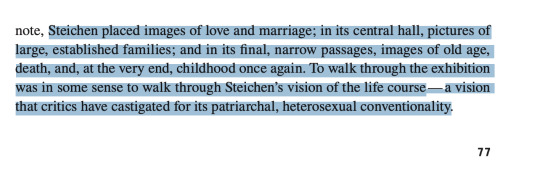
Though since the exhibition there has been critical disdain for the exhibition, claiming its middlebrow aesthetics ignore the the issues of sexual and racial repression in 1950s America, the article notes that some critics imply that the exhibition is a form of pro-American propaganda, belonging alongside ‘covert violence, puppet government and military invasions as a tool of American imperialism’. However, it is worth noting the clearly utopian, anti-authoritarian vision behind the exhibition, with the aim of getting the audience to create their own narratives from the images.
It’s a really interesting method of curating an exhibition that gives much more freedom for visitors to create their own conclusions from the work, rather than being led through a strict narrative. The diagram in the screenshot I took from the documentary reminds me of the illustrations from occult or alchemy books in my previous visual research. It has a mathematical look of it that would work well as part of my mixed media pieces, alongside religious or occult illustrations. The use of the eye within my work as well as in a lot of conspiracy related artwork could help to clearly communicate the ideas I’m developing within my work with subtle hints to conspiracy related imagery.
0 notes
Link
Above is a link to an exhibition overview from 2018 at the Met Museum, exploring the theme of conspiracy in art from the 60s to the present. There were a lot of really interesting artists involved that caught my attention, that I’d like to research into further.
The exhibition is divided into two parts: The first half explores deceit and communities in crisis, working with facts and research as the basis for the work. The artist Mark Lombardi creates huge pencil drawings of webs or flowcharts, documenting links between figures in finance, government and the military-industrial complex. Trevor Paglen takes photograph’s of ‘black sites’ where people would be taken by the US Government to be tortured. I was really drawn to the work of Jenny Holzer, who uses text from government documents in public spaces as LED signs. I think it could be an interesting idea to use Government documents and excerpts of text as part of the collage aspect of my work, working on top of it with lots of layers to give it the look of an old artefact which would fit in with the theme of create work as part of an imagined future.
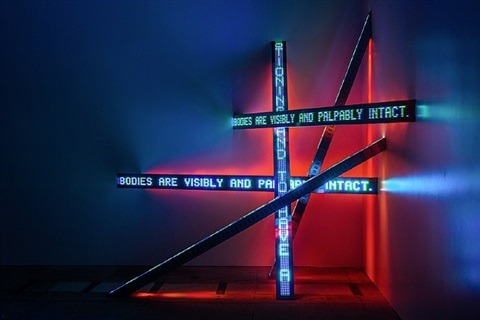
The second part explores the stranger side of conspiracy, with artists such as Jim Shaw and his Martian Portraits, displaying self-portraits of people next to their Martian Doppelgängers. I love the sinister tone that the work evokes with the blurred effect of the portraits. I think it could be interesting to do something similar with the images I use in my work, such as political figures or the monarchy, creating side by side portraits of them with their conspiratorial depiction as an alien or as a reptilian creature, referencing the more extreme conspiracies that suggest the elite are actually non-human. I think it will be really intriguing for my practise to also research into how these types of conspiracies arise as a result of the socio-political climate and distrust in the Government from the 1960s onwards. Soft pastels or charcoal could work really effectively to evoke the same ghostly look as these portraits:
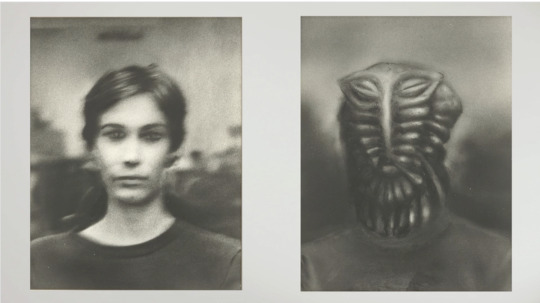
I looked further into critical overviews of the exhibition, particularly this one:
https://bordercrossingsmag.com/article/everything-is-connected-art-and-conspiracy1
The writer flags up the crossovers between political protest and conspiracy, and how it is important to have the distinction between political art and conspiracy so that the reliable facts and genuine issues are not lost under the blanket of conspiracy:
“One mistake the show made, however, is the analogized overlapping drawn between conspiracy theory and political protest. In conspiracy theory, we are in fact speculating...we do not know for sure what truth there is to our conjectures.”
“In political protest...we are at the least operating with a large degree of reliable knowledge...even in calling for greater governmental transparency.”
“The thing about art about conspiracy theory is, when it’s really good, it provides an explanation for why these (mostly) seemingly questionable theories exist.“
I think its useful when going to explore this in my practise, especially considering that i am investigating both very real political issues and systems alongside ideas that go agains the narrative, that I don’t loose the impact of genuine socio-political themes. I think that the method brought up in my 1 to 1 crit will be helpful: Having an alter-ego that I can use in my work to delve a lot deeper into extreme conspiracies, allowing me to be objective about them and pick out the pieces of genuine concern and truth from the theories.
0 notes
Photo
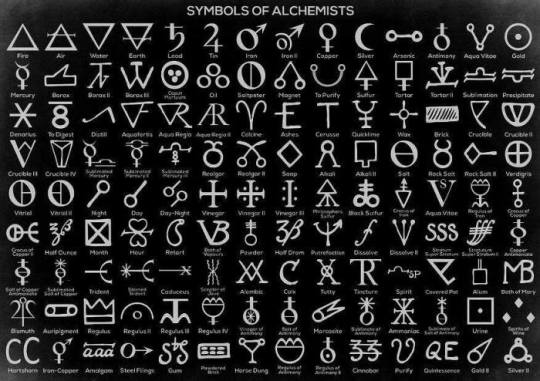
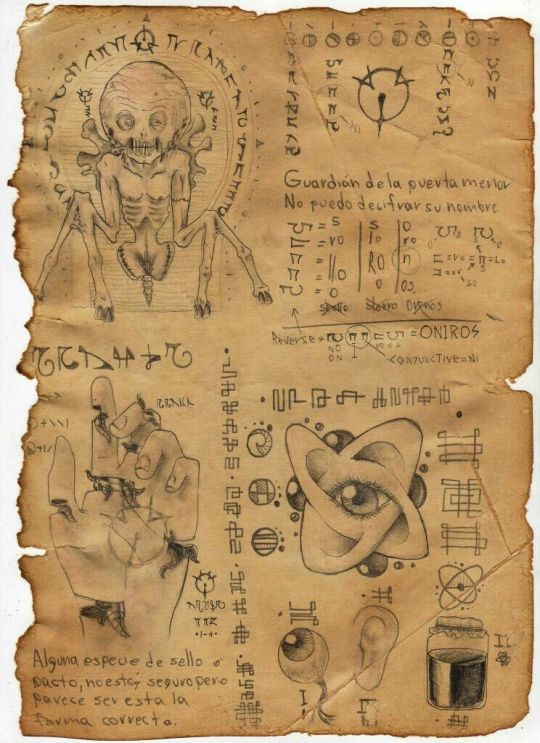

Occult/Alchemy symbols for visual research
These are a handful of images taken from the internet that I’ve been using in my work. I plan to use these as inspiration for depicting my own ideas I the format of a cultural artefact, communicating systems of power and corporate control society as a semi-religious cult. Some of the illustrations remind me a lot of the large Lino-print that I made a few weeks ago. I’d like to do more prints in a similar style as I think it worked really effectively. The mostly monochrome line drawings, circles, straight lines, and use of symmetry is similar to other religious iconography in Buddhism/Hinduism, such as the precise geometry in mandalas that I’ve also been drawing upon to influence my work.
I think it could be interesting to take some of these motifs and recreate them in a similar style as sketches or pen drawings, working on top with collage and painted elements to create mixed media pieces. The symbolism in the image also reminds me a lot of tarot cards which I could look further into as way of presenting my work, possibly creating a series of Tarot cards working with the cycle of consumerism: buying, using up and replacing reflected in 3 tarot cards hinting to religious or spiritual presence of corporations within our lives. From my 1 to 1 Crit this week, we discussed how I could push the ideas in my work further, creating a possible paranoid alter-ego to bring into this imagined dystopia I’ve been visualising through my practise, exploring themes of conspiracy whilst keeping an objective position outside of the work.
0 notes
Text
Joel Bakan Reddit AMA

I researched further about the producer of the documentary ‘The Corporation’, Joel Bakan, reading through his AMA on Reddit from last year, in which I could understand his more recent takes on the subject:
I think that he makes an interesting observation here, that we seem to have varying ideas of freedom that are in turn impacting our ability to implement meaningful change. I saw this play out over the weekend when Kill The Bill protestors crossed paths with Anti-Lockdown ones, seeing the hostility and division between working class people. Both sides’ ideologies are underpinned by a need for freedom, on one side they want freedom through community, being able to express yourself however you choose, feel safe and have regulations in place to create an equal environment. On the other, it is the need for lack of government coercion and regulation, freedom to think or act how you want without the Government or the media influencing you. Though ultimately what binds the two groups together is the opposition to an authoritarian state, so why aren’t we coming together as a collective to fight against what is essentially the same thing?
I believe that our globalised culture along with the polarisation of opinions thanks to social media algorithms creating ‘echo-chambers’ is partly to blame. Our problems are no longer local to the community, but worldwide, leaving us paralysed with no way of solving all of the issues going on at the same time. Somebody in the UK is unlikely to be able to do anything to help with a crisis happening on the other side of the world, yet virtual connection means that we are made constantly aware, bombarded with so many different issues that we unable to take any meaningful action.
Both sides have been infiltrated by extremism. On the left - pointless ‘cancel culture’ and ‘woke-ness’ alienates older generations, who, rather than knee-jerk reactions, need to be approached with a more tolerant and educational strategy. The myth of globalisation being an inherently good thing is preventing any genuine criticism of some of its consequences from fear of being automatically labelled a racist. Hatred is also caused between people at the smallest of opinions or beliefs that are irrelevant in light of the broader common goal of a fairer, better world. On the right - the opposition to government regulation of our daily lives, valid discourse regarding pervasive surveillance strategies and hatred of government and media propaganda has been hi-jacked by violent alt-right extremists and racist Neo-Nazis.
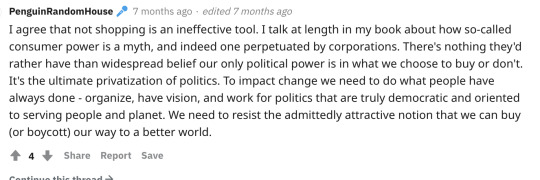
I am particularly fond of his answer here. I agree that the way in which the general population has been convinced that their individual actions are the key to changing the system has little to no effect in generating widespread results. Especially regarding climate change, it is always put down to the individual to recycle, don’t litter, drive less, walk more, pay more for sustainable items, when it is the corporations that are the biggest perpetrators of climate destruction and are never held accountable or forced through regulation to change. But this again links to the set up of the system in the first place: The Corporation’s only goal is profit. They are designed that way. A policy that improves the planet is likely to decrease profit - for a corporation that is not possible. In turn, the ties between corporation and government as aspects of our lives become increasingly privatised also prevents meaningful regulation being established. A law that negatively effects the wealth and power of the elite will never go through in the first place. Making the population aware of the myth of consumer power and instead encouraging community mobilisation to put pressure on these corporations is the way forward.
0 notes
Link
The Corporation (2003)
This is a documentary that I watched recently that dresses a lot of ideas I’m exploring in my practise. The film explores the birth of the corporation as a relatively insignificant entity, taking us through the history of its development into the pervasive and dominant institution of our time. It also gave me a more rounded view of the corporation as an entity, and representations that I could use in my work. I made notes as I watched which are below.
The corporation is today’s dominant institution - an institution that creates great wealth but also causes hidden harms
Can be represented as:
A family unit
Working together for a common end
A Monster
Devouring as much profit as possible
Frankenstein’s creation
Frankenstein’s monster has overpowered him in the same way the corporation has done with us
Birth of corporation
Born out of the Industrial Age
Considered a subordinate entity with the aim to serve the public good
Industrial revolution was the catalyst for an explosion of corporation, railroad, manufacturing, banking
Realised they needed more power:
14th amendment - cannot deprive a person of life, liberty or property - aimed to protect newly freed slaves
Corporation lawyers exercised this right, claiming the corporation as a person
Judges began to apply the same rights intended for people, to property and capital
‘Good’ and ‘Bad’ Corporations
Corporations can direct you to believe that they have values and belief systems, but the bottom line will always be profit above anything else because that is what they are designed for
Need to be seen as constructive members of the society, by interacting with identity politics eg: Amazon promoting BLM whilst busting unions at the same time.
Guise of ‘good’ corporations that are expected to do the right thing
Profit over all else:
Legally required to place the financial interests of their owners above competing interests
Noam Chomsky claims they are “concerned only for the short-term profit of their stockholders”
There is no malevolence or evil intended, only...
“characteristics that enable it to do that for which it was designed” in the same way a shark is designed to kill, there is no will involved”
1940s
Became possible to produce new chemicals for new purposes
As the petrochemical era grew, warning signs emerged that could pose hazards
Synthetic chemicals that had permeated our world could produce cancer and other toxic effects
Risks were attempted to be trivialised, industry is largely responsible
The corporations are essentially a doom machine:
For wealth and prosperity, we created something that is going to destroy us due to the characteristics of the corporation - there are no good corporations, only illusions and fronts - profit is the objective and the way they are set up means they cannot do anything else. Doing wha tis morally right is not within the rules or culture of the game
Cliff analogy:
A plane is pushed off of the edge of a cliff. At first it seems as if it is flying, when in fact it is in free-fall.
“The very high cliff represents the unlimited resources we seem to have when we began this journey, the craft isn’t flying because its not built according to the laws or aerodynamics. Our civilisation is not flying because it’s not built according to the laws of aerodynamics for civilisations that would fly. The ground is still a long way away, but some people have seen that ground rushing up sooner than the rest of us have”.
Privatisation of industry
With privatisation, we’re seeing yet another private taking over of the common
Who creates wealth? Wealth is only created when it is owned privately
Clean water, fresh air, are only seen as a form of wealth when an entity puts a fence a fence around it and declares it private property? - wealth usurpation instead of wealth creation
Public institutions are not out to make profit, they can maintain employment in recession
Eventually everything will be owned by somebody, health, essential services, human rights, education, housing, water, air
Products and child consumerism
Products aren’t bad or good, its the manipulation into buying of the products
Study was done on nagging and the influence of nagging on buying of products - if children nag, parents are more likely to buy the product
Marketers play to children’s developmental vulnerabilities, honed by psychologists and media technology
The more insight you have about the consumer, the more creative you can be with persuasive technologies, we see this now with surveillance capitalism - the selling and rendering of our data to predict our behaviour so that adverts are likely to be more effective
Despite the fact that this documentary was made in 2003, it still holds a lot of truth about the current state of affairs we find ourselves in concerning corporate influence in day to day life. Though, I do find the same faults with this film and similar, in that they point out the problems and map out the events leading up to our current predicament, but fail to provide any meaningful, achieve-able solutions. It will be really useful to implement some of these analogies of the inner working of the corporation within my work visually. I like the idea of taking the Frankenstein’s monster metaphor and using it alongside religious imagery as part of the broad range of iconography in my mixed media works.
0 notes
Photo

Mixed media piece, working into Lino print
Acrylic, oil and pen
A3 Paper
I’ve been working into the black Lino prints that I did a couple of weeks ago, experimenting with both paint and collage to create mixed media pieces. This is the first of these.
I started with oil, covering the white space around the print in a layer of pale yellow to help generate a more dated look similar to the beige tint in the handmade paper I’d used previously. I then began to paint in the circular shapes reflective of the mandala motifs I’ve been using in my work, painting in corporate logos, as well as bringing in various alchemy/occult symbols from my ongoing visual research. Additionally, I had some leftover cutouts from a previous piece of work that I wanted to use as part of this mixed media piece. I cut up various eyes and glued these on. Repurposing leftover images of Margaret Thatcher, I played around with different compositions, cutting away some parts of the face or repeating others like the multiple mouth’s on the bottom-most image of her that is in this piece.
For this piece I focussed on communicating symbols of power related to the British state, displaying the crown as well as the 3 black squares that make up the BBC logo, repeated along the borders of the work. The BBC can be considered an arm of the British State, serving to uphold outdated values that no are no longer relevant in our post-imperial world. Alongside this is imagery from my Lino-prints that reflect a worldwide presence of corporate control in the style of an ancient artefact. I am quite fond of the vivid primary colours I’ve been using in my work so I implemented them in this piece too. I considered how could further deface the printed images, blacking out the eyes and scribbling over the teeth to create a demon-like image on the page. Additionally, I’ve begun trying out text within my work, inspired by the ‘Kill The Bill’ protests fighting against the government’s proposal for more authoritarian police measures. Seeing the mixture of art and text on signs at these protests encouraged me to begin looking into how i could use text as a powerful means of communication in my work, which could also aid my audience’s understanding of its intended meaning.
It is with this in mind that I’ve started to consider how my work could be less polite and more of a form of protest itself, defacing authoritative and corrupt political figures and representing systems of power visually through the lens of a religious cult.
0 notes
Link
A feature on the InterSekt website.
InterSekt is an art creative with, comprised of lesser known ‘underdog’ artists and creatives. This article is from their 2018 December Spotlight, which I read through and found some interesting artists to inform my practise:
Steven Johnson Leyba:
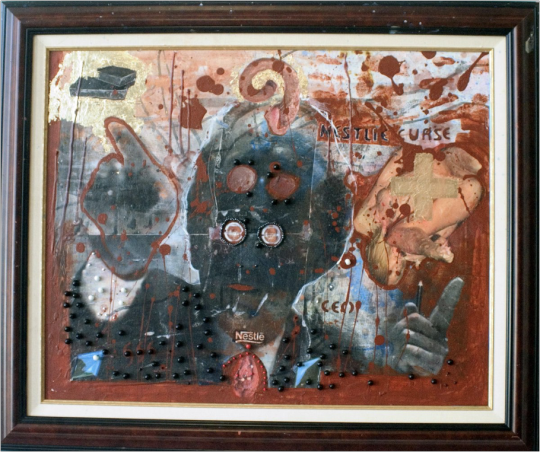
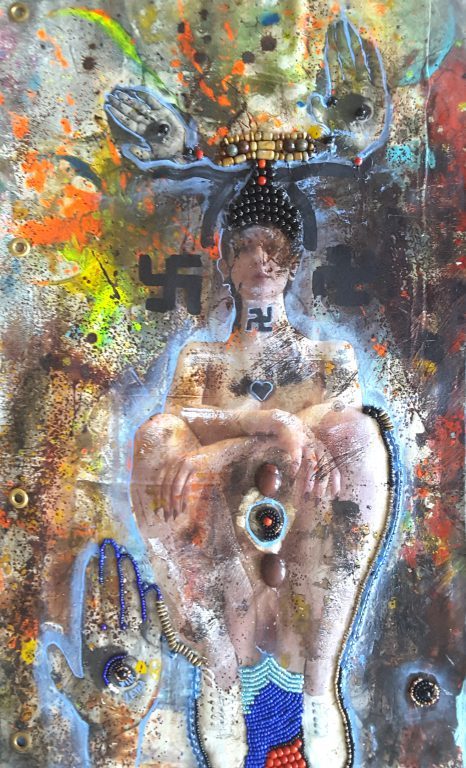
This artist is a shamanistic painter who creates both very personal but also political and radical artworks. He takes a mixed media approach, using paint, collage, beadwork and DNA to communicate statements about our current world. The work above explores the reclamation of the swastika, as well as implementing hints Buddhist motifs and eye and hand symbols.
He creates a number of handmade books. One of these was ‘Monsanto (2010-2011). It was produced through a series of rituals and blood rites and a live piece performing death curse against the corporation. He recently performed a death curse against Nestle, responding to the corporations attempts to bottle water from California. He, alongside a number of other artists, created a church of art, the Coyotel Church. According to this Vice article, the work
“takes a legacy of occult and magical influences, and retranslates it through an open hostility to brands and corporate entities.”
https://www.vice.com/en/article/gvw87b/meet-the-artistsoccultists-channeling-the-death-of-monsanto
The article comments further on the intended meaning of the work:
“lurching beyond the overly ritualized text of social media posts are actual rituals, far less common in this day and age. Whether because of our increased existence in virtual space, or a cultural over-reliance on the written word, we seem to have stepped away from the act itself. The pics, as it were, are more important than the happening.”
The ideas being communicated in this artist is similar to mine. I want to attempt to develop my mixed-media and paint application further to create a more textured, worn-down look to my work, with the aim of opposing corporate entities. Using printed images alongside thick layers of paint could be a good method to try out for this. I also want to look into how I can be more ambitious with my work and the themes, looking into occult rituals and potential spells or passages/diagrams from religious texts to use as visual inspiration. I could also make this easier by choosing a number of topics to focus on solely for each artwork, being more specific about the issues I tackle rather than broader and consequently less effective communication to my audience.
0 notes
Photo
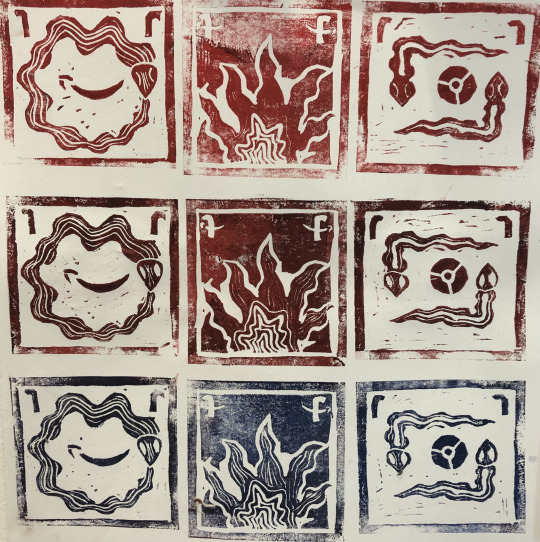
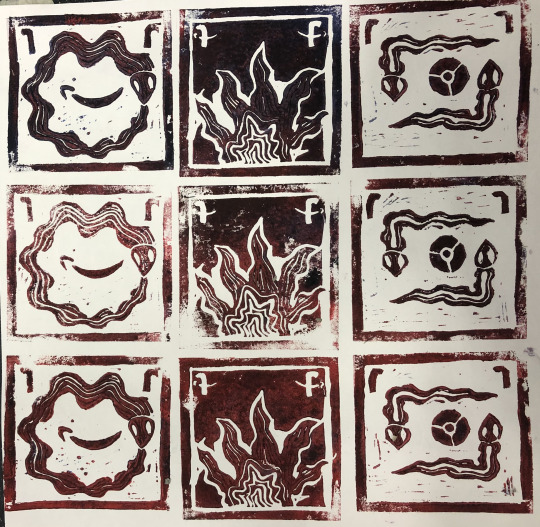
Series of Lino Prints on paper
35cm x 35cm
As well a the large print i made, I also cut out 3 smaller tiles of Lino to create a series of works inspired by the cycle of consumerism. The quote by Victor Lebow:
“Our enormously productive economy demands that we make consumption our way of life, that we convert the buying and use of goods into rituals, that we seek our spiritual satisfaction and our ego satisfaction in consumption. We need things consumed, burned up, worn out, replaced and discarded at an ever-increasing rate.”
I took the ‘ consumed, burned up, worn out, replaced and discarded’ part of this as the basis of these prints, using a combination of Huichol symbols and the Big Tech logos to present a cycle of consuming, using up and replacing. I thought that the idea of a snake eating its own tail would be a good, simple representation of consumption, it also links to cult symbolism to help communicate the concept of my work. Aiming to create the look of a cultural artefact from a past civilisation, I used the Huichol motifs of snakes and fire to help communicate the look of ancient indigenous art, not worrying too much about the preciseness of the lines for these. The second one, I used the image of a fire as a straightforward depiction of burning or using up. For the third, I used the retweet symbol with snakes instead of arrows to present re-use or replacement.
Again I think the fact that I hand printed these works well to achieve faded areas on the prints. For the ink, I tested out both red and blue in the first images, before using a mix of black and red in the second, neater version. The gradient of this works well to show areas of vivid colours in some places and create an overall archaic look.
0 notes
Photo
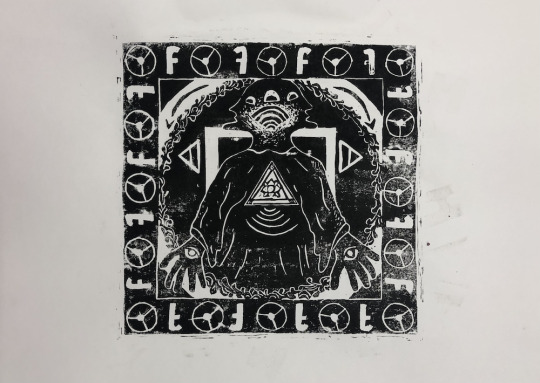



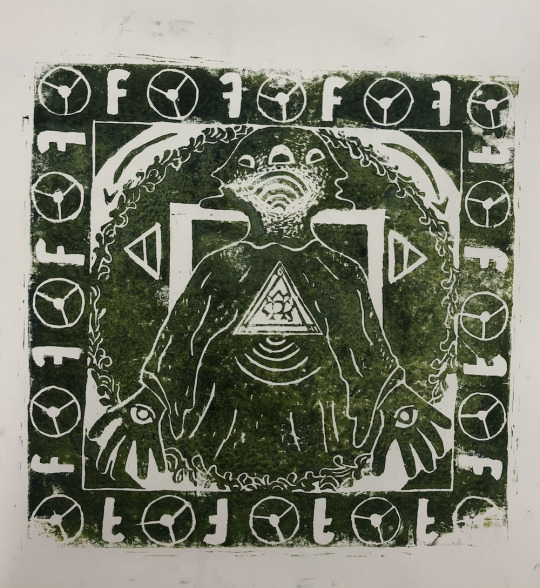

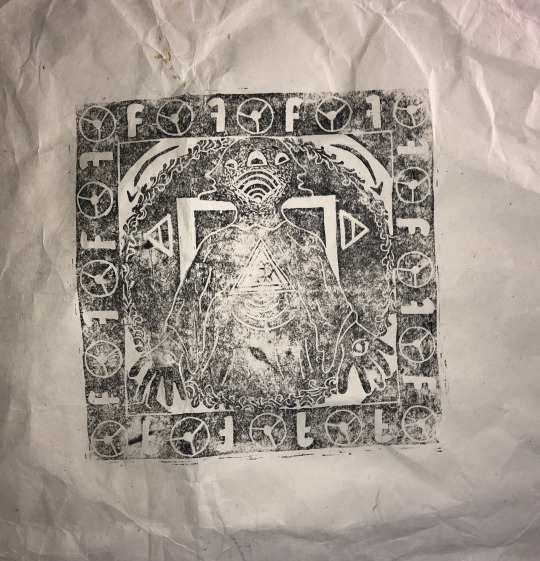
Lino Prints on paper
4 x Lino Prints on plain A3 paper
1 X Lino Print on handmade paper, 70cm x 50cm
These are the Lino prints of the large design that I cut out last week. I printed these in the studio, sing my body weight to press down the prints. I’m really please with how they turned out, I think the less precise and slightly faded effect where the ink didn’t transfer to the paper fully adds to the old/faded look I aimed to produce with these prints. I tried out black, green, red and blue.
I used the same surface for rolling out the different colours so they overlapped slightly and produced some nice gradients on the prints especially the blue one where it is slightly dark er in some areas. I also like the slightly dirtier green I created by working on top of the areas black ink on my rolling surface.
I made multiple copies of the black print, so that I could work into these when they are dry. Using soft pastels around the outside could create a nice contrast between the print, also potentially using acrylic paint would work well too.
I printed one of the designs onto the handmade paper that I can work into once it is dry when I’m next in the studio. I love how the print looks on this paper, I’m definitely going to buy some more sheets of it as it gives a really nice archaic look to the work I put onto it.
0 notes
Photo


Sketch and in-progress Lino-Print cut out
1st image - Pencil and pen on paper, 15cm x 15cm
2nd image - Lino cut-out, 30x30cm
Inspired by the ‘Secret Writing’ artwork by Allyson Grey, as well as the idea of corporate control and consumerism as a cult, I wanted to create a piece that reflects this type of religious imagery or historical artefact of an imagined culture.
I think that Lino-print could be a really effective method of evoking the look of a cultural artefact. The printing press was used broadly to share the knowledge of various religions to the wider society, playing a huge role in Medieval Europe. It had a revolutionary impact, sharing of ideas on a mass scale, thus I think using printmaking will aid in communicating my ideas as pieces of a past society.
I’m really happy with how the print is looking so far. Working on a large scale makes adding in the smaller details a lot easier. Again in this design I used the Facebook and Chrome symbols to generate a language around the border, then in the center used the composition of a mandala to work from the center, using Mexican Huichol imagery to produce a 3-headed figure, including Wifi symbols and the Google Drive logo in the center. Additionally, I took inspiration from the artist Joey Colombo, who uses the idea of money as the central power in our society, creating collages from different currencies. I really liked the way in which the artist takes many different currencies from various cultures to create the images. I liked how the themes of power and control are conveyed through the use of physical objects - money being the most important aspect of everyones life, whether we like it or not. I feel that I have done a similar thing with my work, taking different sources from various cultures to convey the control of corporations in our current world.
0 notes
Link
The artist Joey Colombo creates detailed collages out of currency.
His work explores the significance of money as a universal symbol of power - the most important aspect of our societies. We dedicate our lives to the accumulation of money in order to survive. The artist’s statement expands further on this:
“Money is all about control; who has it, who wants it, how to get it and keep it. The power of my art lies in the act of cutting up the very device of control and in that process transferring that power and making it my own.”
I really love the variety of motifs present in the collages. The work uses currencies from all over the world to communicate the artist’s ideas. The political theme of power and control is present throughout, as well as motifs present in religious or visionary artworks, using the multiple eyes and art deco style embellishments:

The work carries a very poignant themes that comment on political events, for example, the piece titled "Blood Money" and uses Iraqi currency as a base and pieces cut from US and Australian bills on top to comment on the problematic involvement of the West in the middle-east:

I could use similar floral designs in my designs to further create work that reflects this decorative religious art, but instead using corporate logos and digital symbols.
0 notes
Link
The article above expands on the consequences of exponential growth through methods of consumerism on our society.
The post-war boom of consumerism pulled America out of the Great Depression, but it no longer serves us. Due to the engineering of citizens to desire material goods, we have an ever-shortening attention span. We want things quickly, easily and the ability to dispose of them once the next best thing arrives. This works for the elite, whose wealth and power can only increase under this regime, whereas it leaves ordinary folk distracted and complacent, the environment destroyed beyond repair. The article discusses the exploitation of nature and animals within the advertising of products to ‘actively recruit consumers’. For example, the fast, smooth movements of a Lion or Tiger for car adverts.
Analyst Victor Lebow claimed in 1955:
“Our enormously productive economy demands that we make consumption our way of life, that we convert the buying and use of goods into rituals, that we seek our spiritual satisfaction and our ego satisfaction in consumption. We need things consumed, burned up, worn out, replaced and discarded at an ever-increasing rate.”
This is another quote that I am using to influence my practise. The idea of spiritual fulfilment and ritual in regards to consumerism is a comparison I’m exploring though my work, using religious iconography to translate quotes such as these into a visual format. I like the idea of creating a series of prints or designs to represent the cycle of ‘Consumed, burned up, worn out, replaced and discarded’. I could make 5 small lino-prints to reflect each one, using cult and religious symbols to make the connection between consumerism and surveillance technology as an almost religious practise.
0 notes
Photo
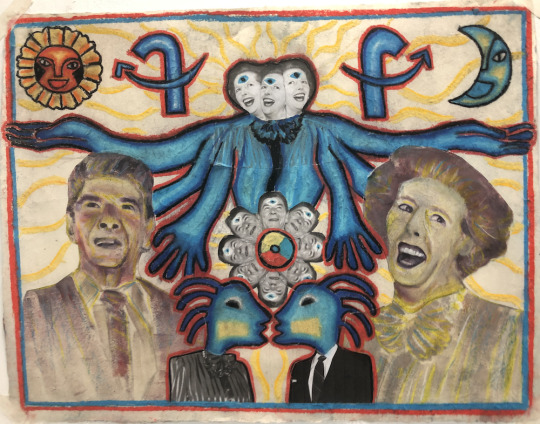
Finished version of mixed media piece
Soft pastel, oil paint and collage on handmade paper
70cm x 50cm
I like some of the ideas I’ve put into this piece of work. Again, the pastels stand out really well, I like how they look alongside the collage of printed images. I don’t think the painted portraits work as well here, I used purples and yellows to create an old, faded look but I don’t think it looks that great alongside the vibrant pastels. I used religious motifs as influence, focusing on how divine or sacred figures are depicted, then applying this to my own collection of political and corporate imagery.
I think that using collage to present my ideas rather than painting them allowed me to work quicker, getting straight to what I want to communicate and giving me more time to spend on the composition. I could use collage elements to help contrast my ideas more easily too. I’m not that keen on the Huichol style sun and moon in this either, they are a little small so it was difficult to get precise lines using the pastels, I think the work in general looks like its lacking something, this is likely because the faded colours in the painted portraits are too similar to the colour of the paper. I think the ideas in this would look a lot better if I just used pastels and cut outs arranged on the paper, I would like to revisit this composition again, perhaps making it again but changing the layout and thinking more carefully about use of colour, the work I’ve been making recently that I’ve liked the most has used strictly primary colours and black and white.
1 note
·
View note